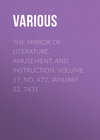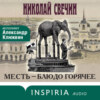Читать книгу: «The Mirror of Literature, Amusement, and Instruction. Volume 17, No. 472, January 22, 1831», страница 5
J. ST. J.L.
Fraser's Magazine.
RETROSPECTIVE GLEANINGS
HISTORY OF THE PENNY
(For the Mirror.)
"She sighs and shakes her empty shoes in vain,
No silver-penny to reward her pain."
Dryden.
According to Camden and Spelman, the ancient English penny2 was the first silver coin struck in England, and the only one current among our Saxon ancestors.
In the time of Ethelred, it was equal in weight to our threepence. Till the time of King Edward I. the penny was struck with a cross, so deeply indented in it, that it might be easily broken, and parted on occasion into two parts, thence called half-pennies; or into four, thence called fourthings, or farthings; but that prince coined it without indenture, in lieu of which he struck round halfpence and farthings. He also reduced the weight of the penny to a standard, ordering that it should weigh thirty-two grains of wheat taken out of the middle of the ear. This penny was called the penny sterling. Twenty of these pence were to weigh an ounce; whence the penny became a weight, as well as a coin. By subsequent acts it has been further reduced. In ancient statutes, the penny was used for all silver money; hence the ward-penny, the avert-penny, the rete-penny, &c.
The ward-penny was formerly a customary due paid to the sheriff, or other officer, for maintaining watch and ward. It was payable at the feast of St. Martin; and is still paid within the manor of Sutton Colfield, in Warwickshire, and that with some very singular ceremonies.
The aver-penny, or average-penny, was contributed towards the king's averages, or money given to be freed thereof.
The rete-penny was an ancient customary due of one penny for every person to the parish priest.
The schar-penny was a compensation paid by tenants who neglected to pen up their cattle at night in the pounds or yard of their lord, for the benefit of their dung, or scearn, as the Saxons called it.
Peter-pence were an ancient tax of a penny on each house throughout England, paid to the Pope. It was called Peter-pence because collected on the day of St. Peter ad vincula. By the Saxons it was called Rome-feoh—i.e. the fee of Rome; and also Rome-scot, and Rome-pennying, because collected and sent to Rome. And lastly, it was called hearth-money, because every dwelling-house was liable to it, provided there were thirty pence vivae pecuniae belonging to it—nay, every religious house, the Abbey of St. Alban's alone excepted. It was finally prohibited under Queen Elizabeth.
"The money of England (says Chamberlayne) was abused and falsified for a long time; till Queen Elizabeth, in the year 1560, to her great praise, called in all such money; since which time, no base money hath been coined in the Mint of England, but only of pure gold and silver, called sterling money; only of latter time, in relation to the necessity of the poor, and exchange of great money, a small piece of copper, called a farthing, or fourth part of a penny, hath been permitted to be coined; and so likewise an halfpenny of two farthings."
Penny pieces of copper were first issued in England June 26, 1797.
N.B. This is a penny article, but it is hoped the reader will not object to pay twopence for it.
P.T.W.
ORIGIN OF BAIL
(For the Mirror.)
"Worry'd with debts, and past all hopes of bail,
The unpity'd wretch lies rotting in a jail."
Roscommon.
The system of giving securities, or bail, to answer an accusation, is a custom (says Brewer) which appears to have been coeval with the Saxon nation. This system was, indeed, subsequently carried by the Saxons to a burthensome and degrading height—not being confined to those who were accused of crime, but extending to the whole community, who thus gave surety to answer anticipated criminality. This object was effected by the division of England into counties, hundreds, and tithings, and by the direction that every man should belong to some tithing or hundred; which divisions were pledged to the preservation of the public peace, and were answerable for the conduct of their inhabitants.
The system of placing all the people under borh, or bail, the origin of which was attributed to Alfred, is first clearly enforced in the laws of Edgar.
P.T.W.
ANCIENT DIVISIONS OF THE DAY
(For the Mirror.)
"See the minutes how they run:
How many makes the hour full compleat,
How many hours bring about the day,
How many days will finish up the year,
How many years a mortal man may live."
Shakspeare.
The Chaldaeans, Syrians, Persians, and Indians began the day at sun-rise, and divided both the day and night into four parts. This division of the day into quarters was in use long before the invention of hours.
The Chinese, who begin their day at midnight, and reckon to the midnight following, divide this interval into twelve hours, each equal to two of ours, and distinguished by a name and particular figure.
In Egypt the day was divided into unequal hours. The clock invented by Ctesibius, of Alexandria, 136 years B.C. was so contrived as to lengthen or shorten the hours.
The Greeks divided the natural day into twelve hours—a practice derived from the Babylonians.
The Romans called the time between the rising and setting sun, the natural day; and the time in the twenty-four hours, the civil day. They began and ended their civil day at midnight, and derived this practice from their ancient jurisprudence and rites of religion, established long before they had any idea of the division into hours. The first sun-dial seen at Rome was brought from Catania, in Sicily, in the first punic war, as part of the spoils of that city; and after this period, they divided the day into twenty-four hours. An officer, called accendus, used to proclaim the hours; and at the bench of justice (says Kennett) gave notice every three hours what it was o'clock.
Throughout the Turkish empire, time is reckoned by certain portions of the natural day, resembling the vigils of the ancient Jews and Romans. Public clocks not being in use, these divisions of time are proclaimed from the minarets.
P.T.W.
THE TOPOGRAPHER
TRAVELLING NOTES IN SOUTH WALES
Voyage up the Bristol Channel.—Two steam-packets ply twice every week throughout the year between Bristol and Swansea. The opposition has been so great this season, that the cabin fare is only 5s. and the steerage 2s. 6d. for a distance of seventy-five miles. The voyage down is performed in fine weather in about six hours; while, in consequence of the tide being adverse, it requires from nine to ten hours to make the voyage up the Channel. We hardly know any voyage so pleasant of the same length, for the scenery along the shores of the Severn sea, as it is well known, is singularly romantic and beautiful. We will give a rapid description of the voyage to Bristol:—Let us suppose ourselves darting between Swansea pier-heads, in the well-known Palmerston steamer, with her opponent, the Bristol, in her wake. After crossing Swansea Bay, you pass Porthcawl, about fifteen miles from Swansea, where a harbour has been formed, at a great expense, by an extensive new coal company, whose works lie fourteen miles distant. This coast is exposed to all the fury of the Atlantic, the surf against the cliffs appearing very distinct at Swansea; and the task of forming the Breakwater must have been a difficult one. The steamers now keep close along shore, in a channel inside the Nass Sands—an extensive and dangerous bank to seaward. The contrast between the immense and tumultuous masses of breakers over these sands, particularly if the wind is fresh, and the calmness of the narrow channel you are securely traversing, is very impressive. These sands, and another large shoal called the Skerweathers, nearer Swansea, have been fatal to many vessels. In rough weather, however, the steamers go outside, which lengthens the passage considerably. A large West Indiaman, with a cargo of rum, &c., was lost a few years ago on a rock near Porthcawl, called the Tusca, which disappears at high-water; and a dreadful scene of riot occurred amongst the peasantry along shore in consequence. The coast near Porthcawl appears at Swansea to be the eastern extremity of the bay; but the bluff point called the Nass, about eight miles farther, is so in reality. The coast onwards past the Nass point is almost perpendicular, the limestone lying in horizontal strata, so as to closely resemble a very lofty wall. There are several breaks or openings of extreme natural beauty as you proceed, which have a double effect on the mind when contrasted with the stern scenery of this wild coast. St. Donat's Castle, the residence of Mr. T.D.T. Drake, an extensive and antique structure in fine preservation, with its venerable towers partly embosomed in wood, is extremely beautiful. The park, studded with deer, shelves gradually down to the shore; a lofty watch-tower on the heights, and the hanging terraces, must command a splendid view. St. Donat's Castle is said to have been built nearly a thousand years ago, and was very strongly fortified: as many Roman coins have been found here, there has probably been a Roman station near. An extensive cave, accessible only at low water, near here, is said to have been the retreat of St. Donat.—The steamers still keep close along shore, and pass Aberthaw, celebrated for its limestone, till you near the Flat and Steep Holmes, two conspicuous islands in the middle of the Channel, about three miles distant from each other. From a lofty light-house on the Flat Holme, a magnificent view may be obtained on a clear day of the Channel, with Lundy Island rearing its head above the distant ocean:—
"Look round—behold
How proudly the majestic Severn rides
On the sea—how gloriously in light
It rides!"
The Flat Holme, which is nearly ten miles from Cardiff harbour, forms the boundary of the port of Bristol; and every seven years the mayor and corporation of that city visit it, and go through some ceremonies prescribed by ancient custom. There are some remarkable and interesting rocks on the Flat Holme: its only inhabitants are a man and his wife, the attendants at the light-house. This man is created sole lord of the island by the corporation of Bristol, and has the exclusive right of fishing round its shores. The Steep Holme is a lofty and barren rock, tenanted alone by the cormorant and the sea-mew: it is smaller than the Flat Holme. The following lines are so beautifully descriptive of this lonely and desolate spot, that we cannot resist transcribing them:
"The sea-bird claims that solitary spot,
And around, loud screaming, wheels
In undisturbed possession: other sounds,
Save those of shrieking winds and battling cliffs.
Are seldom heard in that deserted isle.
The spirit of desolation seems to dwell
Within it; and although the sun is high,
And Nature is at holy peace, it has
An aspect wild and dreary.
But in the wint'ry storm, when all that sea—
The terrible Atlantic—breasts its rocks
In thund'ring conflict, the unearthly howl
Might almost wake the dead."
N.T. Carrington.
But to proceed with our voyage:—Almost opposite the Holmes there is an extensive view on your right of Bridgewater Bay, receding inland; and on the left, Pennarth Roads, with the forest of shipping and town of Cardiff elevated in the distance, present themselves. On this side the Channel there is nothing more to mention—the thriving and very extensive port of Newport on the Uske, in Monmouthshire, about twelve miles above Cardiff, not being visible. This town has risen almost entirely within the present century. It owes its prosperity partly to the excellent quality and hardness of its coal, which is almost equal to that of Newcastle, and partly to an unjust and exclusive act of parliament, which enacts that all coals shipped eastward of the Holmes shall be free of duty, to the great injury of Cardiff, Swansea, and other ports to the westward. The annual shipments to the port of Bridgewater alone, in consequence, are 100,000 tons. You now stretch nearer the Somersetshire coast; and after passing that beautiful and much-frequented little watering-place, Weston-supra-mare, clustering on the side of a romantic declivity along shore, the flood-tide reaches you on arriving in the far-famed King-Road at the mouth of the Avon, which, in addition to the natural beauty of the surrounding scenery, generally presents an animating scene of shipping and steamers, lying off till there is sufficient tide up the river. But we have progressed gently amidst a crowd of small craft past Pill, a fishing village at its mouth; and after being entranced for five miles with the magnificent and varied scenery of that lovely river, the classic and palatial buildings of Clifton, cresting the pinnacle of the rocks, come in sight as you near Cumberland Basin, and form a fit termination to such a scene. But we must recur to this subject.
VYVYAN.
























